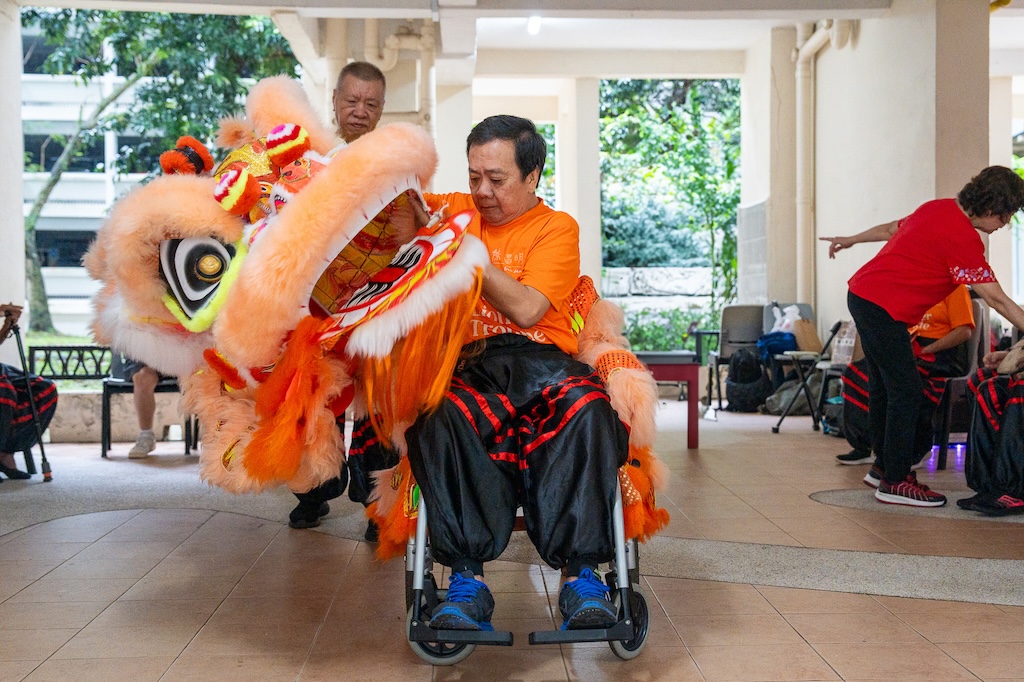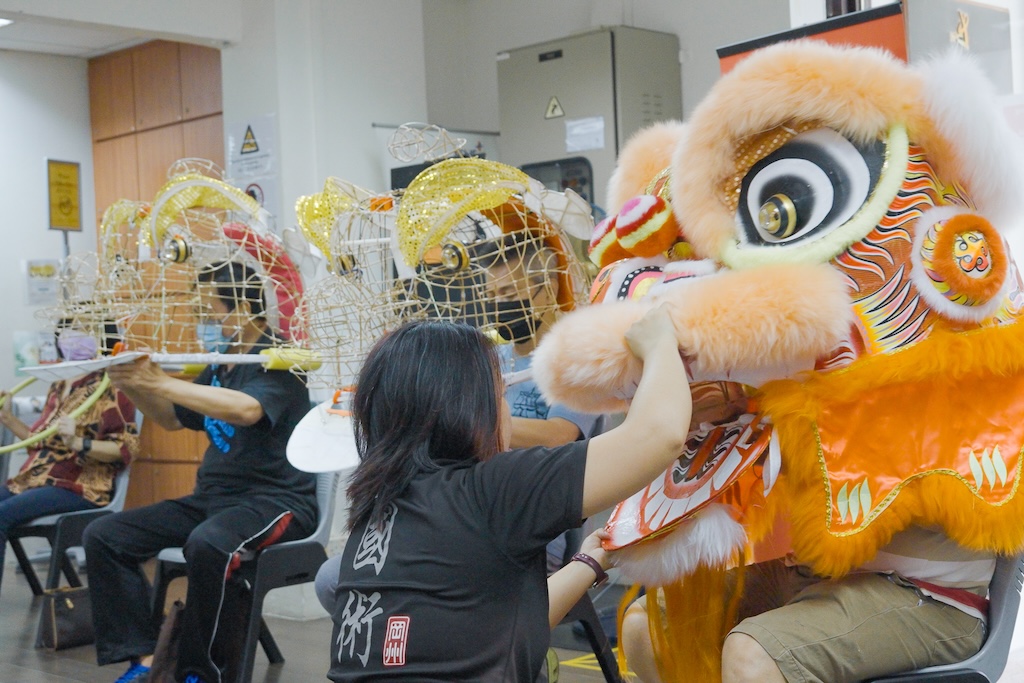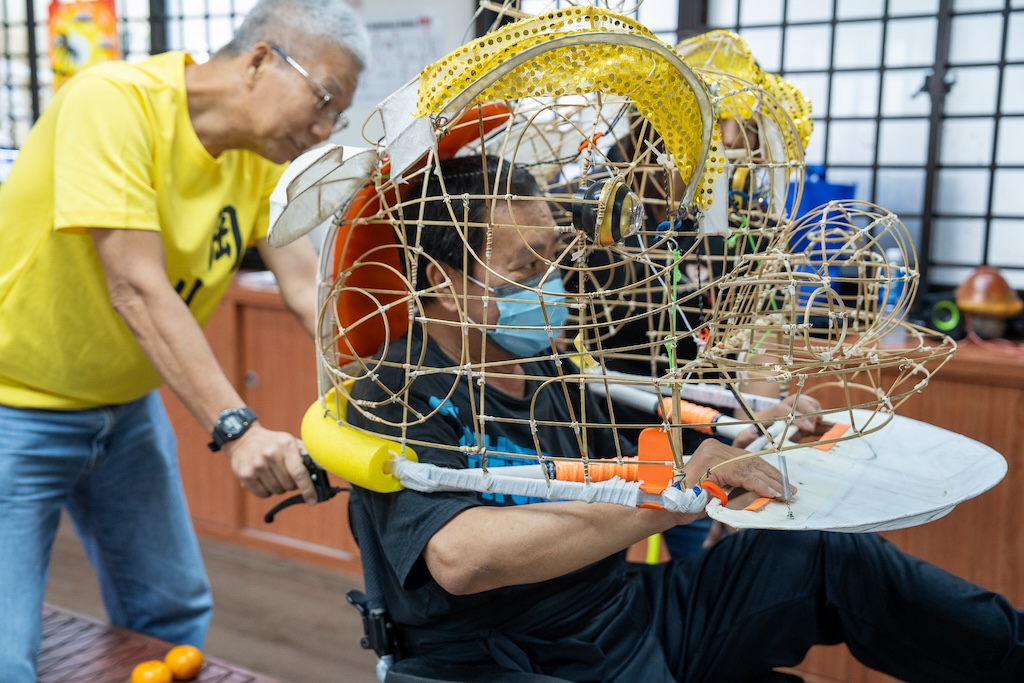Meet “Silver Pride” – Singapore’s first lion dance troupe for seniors
The 23-member troupe went through a training programme specially-designed for seniors, including those with mobility challenges, by lion dance masters at a 184-year-old Chinese clan.

Tan Sung Ming performing the lion dance routine at Blk 2 Holland Close on January 20.
Lion dance is a practice typically regarded as one suited for the young, thanks to its focus on energetic movements, acrobatics and vigorous drum beats. But 68-year-old Tan Sung Ming, a retired process manager, would beg to differ. For the last two months, Tan has spent his Friday afternoons rehearsing alongside over 20 other seniors – ranging in ages from 63 to 99, including some who are wheelchair-bound – on a range of exercises that trained their agility, grip strength and dexterity. Their goal? To be Singapore’s first lion dance troupe for seniors.
On January 20, Tan and his troupe mates debuted as the Silver Pride Lion Troupe (欢银舞狮), showing off their well-rehearsed routine at a Chinese New Year community celebration at Holland Close, organised by social service agency Fei Yue Active Ageing Centre. Minister Chan Chun Sing, who was the guest-of-honour, “dotted the eyes” (點睛) in a traditional act of awakening the lion for its celebratory dance. The troupe also led other seniors in the community in a specially-choreographed chair Zumba exercise that incorporated martial arts and lion dance movements.
The Silver Pride Lion Troupe is part of ‘Inheritage’, a pilot programme created by Lien Foundation, heritage consultancy Bridging Generations, and design studio NextOfKin Creatives (NOK), in collaboration with 184-year-old Chinese clan Kong Chow Wui Koon, and Fei Yue Family Service Centre.
The Inheritage programme was conceptualised as a way to identify the aspects of Singapore’s cultural heritage which has potential to help seniors stay active, healthy and socially engaged. Out of the myriad of traditional arts and crafts, lion dance was selected as it provides for a variety of roles and skills to suit seniors of different abilities, and is well-loved even across different ethnic groups.

Lynn Wong Yuqing assisting the seniors in trying out the lion heads.
Lee Poh Wah, CEO, Lien Foundation, said: “Lion dance is synonymous with vitality, community, celebration and life – the very things we don’t associate with seniors. Seeing them perform such a dance thus helps us break down walls. The lion can be a trojan horse to fight ageism.”
Inheritage builds on the Lien Foundation’s past work in using heritage, arts and sports for aged care. These include the set-up of a 290sqm space at the National Museum of Singapore named Reunion, which is the first purpose-built social space for seniors in a local museum. It also includes Seniors Go!, a series of training programmes that introduced seniors to activities not usually perceived as age-appropriate, such as rock-climbing, e-sports, playing in a rock band and performing magic.
For Inheritage, a team of experts from both within and outside the aged care sector was assembled to work together on finding the balance between tradition and the abilities of the seniors, ensuring safety while retaining authenticity. While many existing lion dance troupes already comprise seniors, they are usually long-time practitioners. What makes Inheritage different is the modified choreography and equipment which makes it accessible to first-timers who are seniors, and the shift from lion dance as a performative and ceremonial function to a vehicle for strengthening health and communities.
To this end, 35-year-old Lynn Wong Yuqing, a local 5th generation disciple of famed martial artist Wong Fei Hong (黃飛鴻), was invited to redesign the choreography for seniors. Wong is the director of Bridging Generations, a homegrown heritage consultancy, as well as a member of the lion dance troupe at Kong Chow Wui Koon.
In adapting the choreography, she consulted with 76-year-old Master Siew Puay Lee (萧培利), a third generation disciple of Wong Fei Hong, also a veteran of the Kong Chow Wui Koon lion dance troupe, to develop a sequence that stayed true to the traditions, symbolism, structure, and formation of a traditional lion dance performance, while tailoring elements for the elderly-friendly lion head.

Master Siew seated on a wheelchair, demonstrating the lion dance routine to the seniors at Kong Chow Wui Koon.
In the training programme’s choreography, the front dancer under the lion head sits in a wheelchair by default, regardless of his or her functional ability, while the dancer who plays the role of the lion’s hind will perform the footwork and manoeuvre the front dancer’s wheelchair at the same time. This configuration allows seniors of all abilities to find a role in the troupe and also acts as a fall prevention measure for the front dancer who would otherwise have to move about with limited visibility while handling a lion dance head with a shifting centre of gravity. Suitable seniors also have the option of focusing on the percussion instead of the dance, by training in the use of the cymbals. The drumming and the gong will be undertaken by trainers, as the drumbeat serves the critical role of anchoring the entire performance.
The training spanned over six two-hour sessions for two months beginning in December 2023. The troupe was first introduced to the lesser known heritage and symbolisms behind the traditional lion dance routine at the Kong Chow Wui Koon. The seniors were treated to a demonstration of the new choreography by Master Siew Puay Lee, himself seated on a wheelchair, assuring seniors of the credibility of the training programme they were about to embark on.
To mark their induction into the troupe, every senior was given a cloth waist belt. Lion dance practitioners typically wear such belts to provide gentle pressure to the abdomen area. This aids deeper breathing through the diaphragm rather than shallow breathing with the chest, and allows for better exertion of strength.
The seniors’ training ground was Fei Yue Active Ageing Centre (Holland Close), where they practised lion dance moves that were deconstructed, then integrated into familiar chair Zumba exercises that seniors already engage in at active ageing centres, imbuing these regular exercises with new meanings and a goal to work towards. These exercises comprised body twists, leg raises and arm extensions that strengthened the same muscles the seniors will use in performing a lion dance. The training programme also introduced the use of exercise equipment that strengthens their wrists and fingers such as stress balls and hula hoops. In this way, chair Zumba was remixed with martial arts and lion dance moves: Picture seniors performing grip strengthening and upper body mobility exercises with stress balls in sync, choreographed to the uplifting theme song of Once Upon A Time in China, a classic movie on the adventures of Wong Fei Hung which also featured memorable lion dance segments. A second exercise used a hula hoop with weights added to it to mimic a lion head.
In all of this, Wong focused on building the troupe’s grip strength, not solely because of the performance, but also because grip strength is key to seniors’ ability to live independently in the community.

Chia Chiang Teck holding onto a hula hoop with weights attached to train his arm strength.
She explained: “From activating the lion’s eyes and ears using our new pulley and lever system to squeezing stress balls in sync with heart-thumping beats in the lion dance chair Zumba routine, we have made grip-strengthening exercises an enjoyable experience for seniors so as to improve their ability to perform Activities of Daily Living (ADLs) such as feeding, toileting, and moving about.”
NOK, worked hand-in-glove with Wong, applying its capabilities in ethnographic research, industrial design, prototyping and branding from its work in consumer products and services.
Through meticulous user testing with at least 30 seniors across two active ageing centres – Fei Yue Active Ageing Centre and Yong En Active Hub – the NOK team prototyped modifications aimed at enhancing user experience and minimising strain for the seniors. For example, it redesigned a pulley and lever system within the lion head. This provides seniors with better control over the flicker of the lion’s eyes and twitches of its ears with minimal effort, an improvement from the conventional centralised string mechanism which is harder to operate for seniors.
Other interventions include padded grips on the lion’s mouth flaps for a more supported hold, and non-slip tapes added to the existing frame to enhance grip stability when manoeuvring the lion head. The metal frame that usually rests on the dancer’s neck was encased in foam for better comfort on seniors’ shoulders. They also specially procured a new type of lion head, made of fabric mesh that provided better breathability and visibility, to apply their design interventions.
As the practice sessions were conducted in residential areas, the NOK team hacked the drums and cymbals to achieve a balance whereby the volume was reduced, but tactile reverberations could still be satisfactorily experienced by the seniors using the percussion.

Tan Sung Ming holding the lion head prototype that has been “hacked” with inclusive design features (see orange components) such as padded grips and non-slip tape to improve grip stability.
Nathaniel Ng, industrial designer from the NOK team, said: “It involved a dynamic dialogue between iterative prototyping in the studio and field testing with seniors over six months. Rapid digital fabrication, such as 3D printing, played a crucial role, enabling us to test a wide variety of ideas quickly.”
To measure the efficacy of Inheritage’s pilot programme, members of the troupe will undergo both quantitative and qualitative assessments. On the quantitative front, the team will be monitoring participants’ blood pressure and grip strength, while on the qualitative front, a survey will be conducted post-programme to better understand if participants reported an improved quality of life, a higher level of social integration and increased emotional well-being.
Male participation rates were almost doubled. Fei Yue Active Ageing Centre (Holland Close) reported a participation rate of 28 percent by male seniors, up from an average of 17 percent in other programmes at the centre. They have also been able to engage with non-Chinese seniors as well as seniors who have not previously engaged with Fei Yue Active Ageing Centre. The seniors had expressed their interest to participate in the sessions after hearing the first and second lion dance practice sessions in the void deck.
Chua Ai Geok, a 71-year-old retired hairstylist and volunteer at Fei Yue Active Ageing Centre who led the chair Zumba exercises said, “As I am not young anymore, there were some steps that I felt were challenging for me, such as when I had to twist my back to mimic the actions of the lion scratching its back. Despite this, I feel that this was a good opportunity for me to learn more about my culture as well as to exercise my body.”
For Tan, the retired process manager who played the role of the lion head, the lion dance training was not just a physical pursuit but a tangible connection to his own cultural heritage. “I have witnessed many lion dances before but I did not know the meaning behind the movements. Learning lion dance reconnects me with my childhood,” he said.

Chua Ai Geok playing the cymbals.
After the completion of the Lien Foundation’s support for the pilot programme, Bridging Generations and NOK will continue to find ways to bring the project to the next phase.
“For the lion dance programme, we want to bring elements of our pilot into more active ageing centres and at the same time develop new modules for seniors to level up, such as learning to drum. To engage with an even wider group of seniors, we hope to utilise more untapped heritage assets in our community by working closely with cultural partners from various ethnic groups to create different pillars of programmes including culinary, arts and music. We are looking for like-minded partners to collaborate with and achieve the goal of engaging 50,000 seniors by the end of this year,” said Wong.
Based on its initial findings, the team hopes to partner medical and research institutions to further study the benefits of heritage-infused active ageing programmes on seniors. The Inheritage team is also keen to partner other cultural practitioners, heritage institutions and philanthropic organisations to transform more heritage assets such as culinary, dance, arts and craft into active ageing programmes.

Me tracy, 65 yro old. Fr young till now l8ke to watch lion dance. Keen to join now. Either dance or drum play even both. Kindly advise the regn procedure of participation. Wirh thks.
Tracy, sorry for the late message. You might want to reach out to Fei Yue Active Ageing Centre on this.